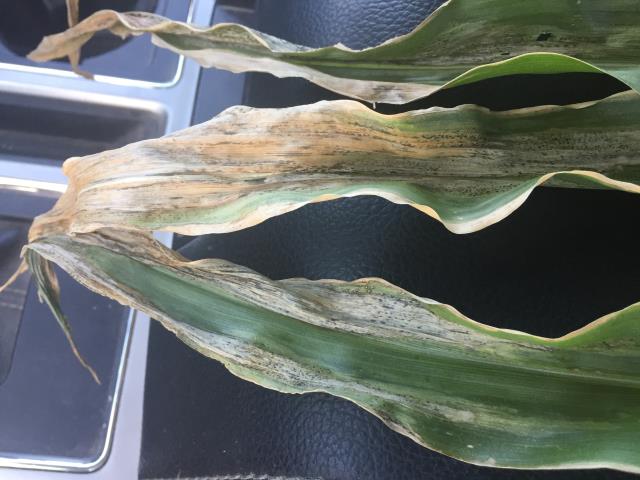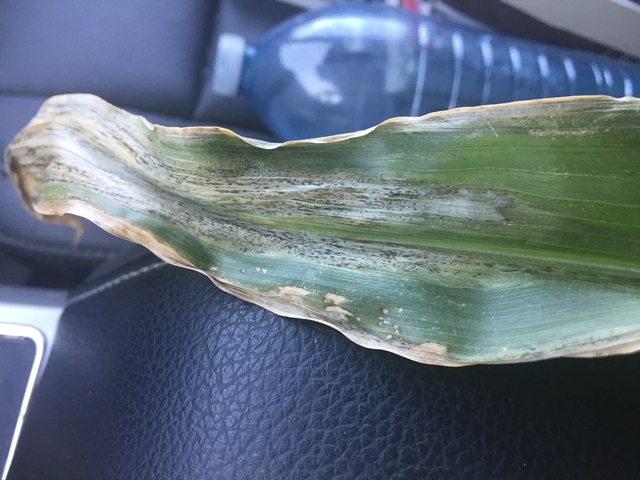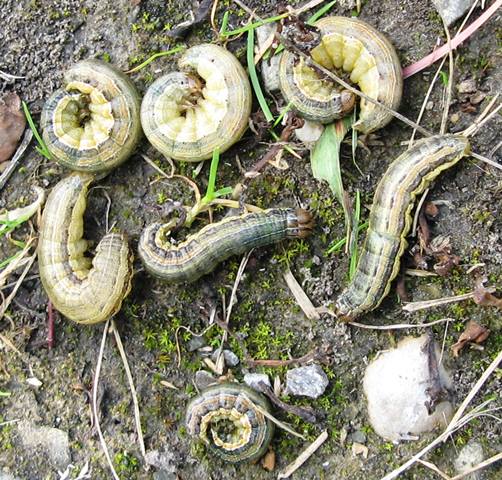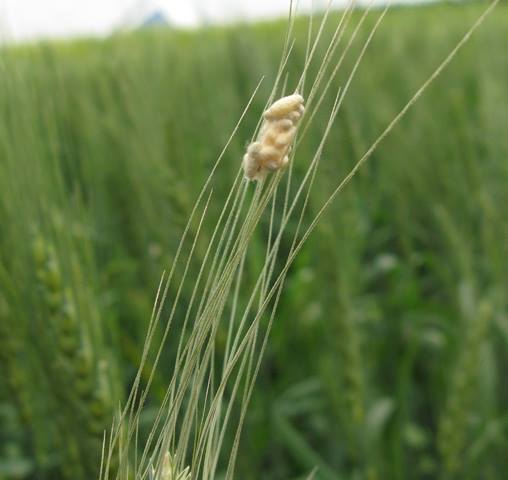Manitoba Insect & Disease Update
Issue 7: July 11, 2018
Summary
Diseases: Goss's wilt was observed near St. Claude.
Insects: Grasshopper populations are being monitored in and around the edges of some fields. Armyworms have been noticed in some cereal fields in the Central and Eastern regions. No soybean aphids have been reported yet.
Goss's Wilt
Early symptoms of Goss's Wilt were observed near St. Claude last week (Figure 1). Symptoms of the disease often move in following wounding from hail and/or sandblasting. This disease has been found in almost all corn-growing regions of Manitoba and may cause yield loss depending on the size of the affected areas in the field and the stage when the crops develop symptoms. Typical symptoms include tan coloured leaf lesions, especially on plants along field edges. The edges of these lesions may appear water-soaked and freckling within the lesion (especially along the margins) will be evident. Under humid conditions, the bacterium causing the disease releases an exudate that will appear shiny in direct sunlight. Since this disease is caused by bacteria fungicides are not effective in its management.


Figure 1. Symptoms of Goss's Wilt observed near St. Claude. Image courtesy of Jason Voogt, Field 2 Field Agronomy.
Armyworms
Armyworms are present in noticeable levels in many areas of Central Manitoba. Larvae can be scouted for by counting the number of larvae per square foot on average. The majority of larvae will be on the ground during the day and often hidden under debris on the soil, under clumps of soil or in crack in soil, so scout the ground thoroughly. Many will curl up when disturbed. The colour of the larvae can sometimes vary considerably between individuals.
Cereal crops can tolerate considerable defoliation from armyworm, and the threshold suggested in cereal crops is 4 or more armyworms per square foot on average. Populations can be very patchy in a field.
A Manitoba Agriculture factsheet on armyworms, explaining thresholds and scouting, is available at: http://www.gov.mb.ca/agriculture/crops/insects/true-armyworm.html

Figure 2. Armyworms
Insect Monitoring Programs
Bertha Armyworm: Out of ninety-nine traps, 93 currently have cumulative counts in the low risk category (less than 300), and six traps are in the uncertain risk category. Most of the highest cumulative counts so far are in the western part of Manitoba. Traps counts in eastern Manitoba and the Interlake have generally been quite low.
Table 1. Highest cumulative trap counts for bertha armyworm adults over the trapping period June 3 to July 11, 2018.
0-300=low risk 300-900=uncertain risk 900-1,200=moderate risk 1,200+=high risk
| Location | Region | Count | Risk |
|---|---|---|---|
| Tilston | Southwest | 863 | Uncertain |
| Somerset | Central | 470 | Uncertain |
| Pierson | Southwest | 444 | Uncertain |
| Inglis | Northwest | 329 | Uncertain |
| Mather | Central | 321 | Uncertain |
| Benito | Northwest | 307 | Uncertain |
| Inglis | Northwest | 292 | Low |
| Miniota | Southwest | 270 | Low |
| Swan River | Northwest | 267 | Low |
This trapping provides information on the regional risk of bertha armyworm potentially getting to higher levels of larvae. The trap counts have little relevance for the field the trap is in, but assessing the traps captures from the various traps in a region can indicate the risk and importance of sampling levels of larvae in a region. At no point should a management decision be made based on trap counts. Such decisions need to be made based on levels of larvae.
No traps have yet to reach cumulative counts in the moderate or high risk range. While scouting canola, assessing levels of bertha armyworm larvae is encouraged, particularly in the western part of Manitoba where a few traps have reached the uncertain risk range.
Insect Identification Quiz
You are scouting a wheat field and notice these clusters at the top of some of the plants. What are they?

Answer: These are not eggs, but clusters of pupal cases of parasitic wasps, likely a species of Cotesia. They are often parasitizing caterpillars such as armyworms, and before the caterpillar dies it climbs to the top of the plant. When you see a large armyworm near the top of the plant during the day, that could mean they are infected with either a parasitoid of pathogen. Healthy older armyworms prefer to take cover on the ground during the day. Many Cotesia larvae will emerge at roughly the same time from the armyworm, and quite rapidly after emergence form these silky pupal cases in a cluster, often high on the plant. So if you are seeing a lot of these, this is a sign that parasitic wasps have been actively working in the field.
----------------------------------------------------------------------------------------------------------------------
Compiled by:
John Gavloski, Entomologist Holly Derksen, Field Crop Pathologist
Manitoba Agriculture Manitoba Agriculture
Phone: (204) 750-0594 Phone: (204) 750-4248
To report observations on insects or plant pathogens that may be of interest or importance to farmers and agronomists in Manitoba, please send messages to the above contacts.
To be placed on an E-mail list so you will be notified immediately when new Manitoba Insect and Disease Updates are posted, please contact John Gavloski at the address or numbers listed above.

